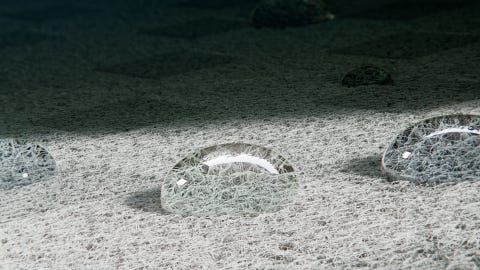Gore-Tex is not your average, run-of-the-mill outdoor brand. It’s a multi-national manufacturing behemoth that doesn’t just supply the world of rugged outwear with durably waterproof fabric; it’s also got its hands in the medical, industrial and military spheres as well. In fact, if you’ve gotten a hernia repaired in the last decade, you could be reading this with a patch of Gore-Tex inside you right now.
But in the outdoors, as far as anyone can remember, Gore-Tex has been synonymous with waterproof-breathable outdoor apparel. Don’t want your ski pants wetting out? Go with Gore-Tex. Need to stay dry during an overnight hunt? Gore-Tex is your go-to. Brands have tried to escape its shadow (remember FutureLight, anyone?) but practically speaking, Gore-Tex is everywhere.
-
 Mountain Hardwear LandSky Gore-Tex Jacket Read More
Mountain Hardwear LandSky Gore-Tex Jacket Read More -
 Patagonia Triolet Jacket [Women's] Read More
Patagonia Triolet Jacket [Women's] Read More -
 Mountain Hardwear Trailverse Gore-Tex Jacket Read More
Mountain Hardwear Trailverse Gore-Tex Jacket Read More -
 Patagonia Triolet Pants [Women's] Read More
Patagonia Triolet Pants [Women's] Read More -
 Norrøna Tamok Gore-Tex Performance Shell Jacket Read More
Norrøna Tamok Gore-Tex Performance Shell Jacket Read More
That ubiquitousness comes with a cost in the form of PFAs and fluorinated chemicals. Recent research has shown that fluorinated chemicals have an adverse effect on both our personal health and the environment around us, but no one's really pushed back.
Even (some) professional athletes would rather have extremely efficacious Gore-Tex in its original formula, even if it comes with a little toxicity. Performance is the only real benchmark, right?
A Game-Changing Hail Mary
Wrong, says Patagonia. The environment-conscious brand, whose biggest shareholder is Mother Earth, set an internal goal to be completely free of PFCS and any other fluorinated materials by 2022 (and while the brand admittedly missed that goal, it's still headed in that direction, with a new goal year of 2025 set). During a meeting with Gore-Tex at Outdoor Retailer in 2018, their team made that very clear: the brand intended to stop using any materials with PFCs, and if Gore-Tex didn't have anything available by then, it was goodbye.
"Patagonia was very clear that their goals were to be PFC-free in their product line by the year 2022," says Matt Decker, Global Technical and Innovation Leader for consumer fabrics, W.L. Gore & Associates. "And we didn't have anything at the time. They were getting ready to leave the meeting when one of our product managers said: 'Wait, there is one thing we're working on. You know, it's not really ready yet, but if you guys want to partner with us on this and see if we can make it ready, I guess we'd be willing to do that.' And that's where it all kicked off right there."
That Hail Mary thrown out by Gore-Tex turned out to be ePe (expanded polyethylene): a new durable, waterproofing membrane that is just as efficacious at repelling water as Gore-Tex's original ePTFE formula — yes, that's short for Expanded Polytetrafluoroethylene — but without fluorocarbons.
Decker shared these details with me during a press event in Bozeman, Montana earlier this year, where we got to test out the tech in some Patagonia outerwear while ice climbing and splitboarding. I'll need more time with it to make a full evaluation, but my initial impression while laboring in the snow was that I wouldn't have known they'd swapped the material if you hadn't told me — which seems like a promising first impression.
It's pretty exciting when you think about it: following years of research and development, the leading manufacturer of waterproof fabrics found a way to remove the most toxic element from its recipe, protecting customers and the environment from exposure.
It turns out ePe already existed before Gore-Tex decided to use it to replace PTFE. What the company managed to do was expand (hence the "little e" in ePe) polyethylene in a similar way that it did its hallmark product, making it more useful, thinner, and just as effective as PTFE — but without the harmful forever chemicals. Because the membrane is thinner and requires less material to produce, it's also more carbon-friendly than its predecessor.
Teamwork Bears (Earth-Friendly) Fruit
After agreeing to take a chance on this new, mostly-unproved membrane, Patagonia gave Gore-Tex access to its wear-testing infrastructure, speeding up the testing process for ePe by years. Pasha Whitmire, who was on staff with Patagonia at the time of the partnership but has since become Material Development Leader at Gore-Tex, sees the upsides from both sides.
"When the Gore team put this product on the table, we were completely blown away," he recalls. "It was exactly what we were looking for. Gore-Tex was really coming to the table with a lot of great scientific, very thorough data around ePe meeting its durability requirements, meeting its water repellency and waterproofness requirements. And so we felt confident from that perspective, but we also wanted to really validate the product in real-world applications."
After years of development and refinement, Patagonia and Gore-Tex successfully brought ePe to market right on schedule in the fall of 2022. But if you didn't hear about the release, that isn't surprising. Gore-Tex did a limited launch of ePe with Patagonia and a few other brands, including Adidas Terrex, Arc'Teryx, Dakine and Salomon; it plans to bring ePe to the broader outdoor market by 2025.
When I asked why, if ePe is as efficacious as ePTFE and less toxic, wouldn't Gore-Tex replace all of its materials with ePe, Gore-Tex representatives told me it was a scaling issue. New supply chains have to be created, products from various brands have to be tested to make sure they live up to Gore's durably waterproof standards and all of this takes time.
But it's coming soon. In Bozeman, the Gore-Tex reps said a major rollout is coming in Fall 2024, and all consumer fabrics will be made with ePe by 2025.
ePE in Practice
If you want to see this more eco-conscious waterproofing technology in action, there are some brands (Patagonia included) already using it. We've picked out a selection below so you can check it out for yourself.





















![Patagonia Triolet Jacket [Women's]](https://hips.hearstapps.com/vader-prod.s3.amazonaws.com/1698155948-83408-ntpl-6537cd9347ae9.png?crop=1xw:1xh;center,top&resize=480%3A%2A)

![Patagonia Triolet Pants [Women's]](https://hips.hearstapps.com/vader-prod.s3.amazonaws.com/1698156090-31180-blk-6537ce1b73a73.png?crop=1xw:1xh;center,top&resize=480%3A%2A)













